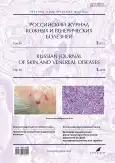Use of oral melatonin in female patients with acne and associated sleep quality disturbances
- Authors: Perlamutrov Y.N.1, Yakovleva E.N.1
-
Affiliations:
- Russian University of Medicine
- Issue: Vol 28, No 3 (2025)
- Pages: 341-350
- Section: DERMATOLOGY
- URL: https://bakhtiniada.ru/1560-9588/article/view/313081
- DOI: https://doi.org/10.17816/dv677825
- EDN: https://elibrary.ru/JFYNYW
- ID: 313081
Cite item
Abstract
BACKGROUND: Sleep disturbances frequently accompany chronic dermatologic conditions and negatively impact patients' quality of life and emotional well-being, often exacerbating disease severity. Statistically, women are more frequently affected, with sleep quality disruptions linked to hormonal fluctuations across various life stages.
AIM: To evaluate the effect of oral melatonin intake on acne severity and quality of life in women.
METHODS: This prospective single-center study was conducted from 2023 to 2024 and included 130 women (mean age, 23.32 ± 2.75 years) diagnosed with mild to moderate acne. Acne severity was assessed using the Global Acne Grading System (GAGS); sleep disturbances were evaluated via the Pittsburgh Sleep Quality Index (PSQI); and the Dermatology Life Quality Index (DLQI) was used for psychosocial assessment. Laboratory monitoring included hormone profiling (luteinizing hormone, follicle-stimulating hormone, 17-hydroxyprogesterone, dehydroepiandrosterone sulfate, free testosterone) and metabolic parameters (insulin-like growth factor 1, insulin, and blood glucose) with HOMA-IR calculation.
RESULTS: Signs of dyssomnia were identified in 65.38% of patients (n = 85), with severity significantly correlating with acne grade (ρ = 0.565; p < 0.001). Patients with sleep disturbances experienced significantly lower quality of life (p < 0.001), elevated free testosterone levels (p < 0.001), and increased IGF-1 (p = 0.008). Combination therapy, including topical agents and oral melatonin administered 30 minutes before bedtime, resulted in faster regression of acne lesions, and improved psychosocial and sleep quality scores.
CONCLUSION: Sleep disturbances are highly prevalent among women with mild to moderate acne. Timely identification and correction of dyssomnia improves treatment outcomes and enhances quality of life.
Full Text
##article.viewOnOriginalSite##About the authors
Yuri N. Perlamutrov
Russian University of Medicine
Email: mgmsu-skin@mail.ru
ORCID iD: 0000-0002-4837-8489
SPIN-code: 2330-2758
MD, Dr. Sci. (Medicine), Professor
Russian Federation, MoscowEvgeniya N. Yakovleva
Russian University of Medicine
Author for correspondence.
Email: en_yakovleva@list.ru
ORCID iD: 0009-0004-0019-3778
SPIN-code: 5158-6775
Russian Federation, Moscow
References
- Vasam M, Korutla S, Bohara RA. Acne vulgaris: A review of the pathophysiology, treatment, and recent nanotechnology based advances. Biochem Biophys Rep. 2023;36:101578. doi: 10.1016/j.bbrep.2023.101578
- Tasneem T, Begum A, Chowdhury MR. Effects of acne severity and acne-related quality of life on depressive symptoms among adolescents and young adults: A cross-sectional study in Bangladesh. Front Psychol. 2023;14:1153101. doi: 10.3389/fpsyg.2023.1153101
- Bagatin E, de Freitas TH, Rivitti-Machado MC, et al. Adult female acne: A guide to clinical practice. An Bras Dermatol. 2019;94(1):62–75. doi: 10.1590/abd1806-4841.20198203
- Barbieri JS, Fulton R, Neergaard R, et al. Patient perspectives on the lived experience of acne and its treatment among adult women with acne: A qualitative study. JAMA Dermatol. 2021;157(9):1040–1046. doi: 10.1001/jamadermatol.2021.2185
- Kail-Goryachkinae MV. The role of endogenous and exogenous triggers in the development of acne. Clinical Review for General Practice. 2023;4(2):90–96. doi: 10.47407/kr2023.4.2.00210 EDN: UWBDSA
- Altunay IK, Özkur E, Dalgard FJ, et al. Psychosocial aspects of adult acne: Data from 13 European countries. Acta Derm Venereol. 2020;100(4):adv00051. doi: 10.2340/00015555-3409
- Lyu F, Wu T, Bian Y, et al. Stress and its impairment of skin barrier function. Int J Dermatol. 2023;62(5):621–630. doi: 10.1111/ijd.16598
- Zhu J, Peng K, Zhang Y, et al. Sleep quality, circadian preferences, and mood among patients with acne vulgaris: A case-control study. Sleep Breath. 2023;27(5):1997–2003. doi: 10.1007/s11325-023-02777-5
- Gryazeva NV, Tamrazova AV. Assessment of quality of life in patients with severe acne. Medical alphabet. 2021;(9):12–15. doi: 10.33667/2078-5631-2021-9-12-15 EDN: WMIBDT
- Vasey C, McBride J, Penta Circadian K. Rhythm dysregulation and restoration: The role of melatonin. Nutrients. 2021;13(10):3480. doi: 10.3390/nu13103480
- Gubin DG, Poluektov MG. Light hygiene, biological rhythms and sleep disorders. Effective pharmacotherapy. 2024;20(33):6–12. EDN: MUTDXT doi: 10.33978/2307-3586-2024-20-33-6-12
- Poza JJ, Pujol M, Ortega-Albás JJ, et al. Melatonin in sleep disorders. Neurologia. 2022;37(7):575–585. doi: 10.1016/j.nrleng.2018.08.004
- Tamschick R, Navarini A, Strobel W, et al. Insomnia and other sleep disorders in dermatology patients: A questionnaire-based study with 634 patients. Clin Dermatol. 2021;39(6):996–1004. doi: 10.1016/j.clindermatol.2021.09.001
- Xerfan EM, Andersen ML, Facina AS, et al. Sleep loss and the skin: Possible effects of this stressful state on cutaneous regeneration during nocturnal dermatological treatment and related pathways. Dermatol Ther. 2022;35(2):e15226. doi: 10.1111/dth.15226
- Haufe A, Leeners B. Sleep disturbances across a woman’s lifespan: What is the role of reproductive hormones? J Endocr Soc. 2023;7(5):bvad036. doi: 10.1210/jendso/bvad036
- Sam S, Ehrmann DA. Pathogenesis and consequences of disordered sleep in PCOS. Clin Med Insights Reprod Health. 2019;13:1179558119871269. doi: 10.1177/1179558119871269
- AbdElneam AI, Alhajlah S, Al-Dhubaibi MS, et al. In severe acne vulgaris, TNF-α gene variants are connected to increased TNF-α gene expression and insulin resistance. Skin Res Technol. 2024;30(7):e13811. doi: 10.1111/srt.13811
- Nguyen S, Nguyen ML, Roberts WS, et al. The Efficacy of metformin as a therapeutic agent in the treatment of acne vulgaris: A systematic review. Cureus. 2024;16(3):e56246. doi: 10.7759/cureus.56246
- Adeva-Andany MM, Domínguez-Montero A, Castro-Quintela E, et al. Hypoxia-induced insulin resistance mediates the elevated cardiovascular risk in patients with obstructive sleep apnea: A comprehensive review. Rev Cardiovasc Med. 2024;25(6):231. doi: 10.31083/j.rcm2506231
- Souza JF, Monico-Neto M, Tufik S, et al. Sleep debt and insulin resistance: What’s worse, sleep deprivation or sleep restriction? Sleep Sci. 2024;17(3):e272–e280. doi: 10.1055/s-0044-1782173
- Scutari M, Kerob D, Salah S. Inferring skin-brain-skin connections from infodemiology data using dynamic Bayesian networks. Sci Rep. 2024;14(1):10266. doi: 10.1038/s41598-024-60937-3
- Mann C, Gorai S, Staubach-Renz P, et al. Sleep disorders in dermatology: A comprehensive review. J Dtsch Dermatol Ges. 2023;21(6):577–584. doi: 10.1111/ddg.14992
- Zafari Zangeneh F. Deregulated Brain’s central clock management on sleep-wake behavior in women with polycystic ovary syndrome: Melatonin and sleep pattern. J Family Reprod Health. 2022;16(4):229–238. doi: 10.18502/jfrh.v16i4.11348
- Dutil C, Podinic I, Featherstone RB, et al. Sleep and insulin sensitivity in adolescents at risk of type 2 diabetes: The sleep manipulation in adolescents at risk of type 2 diabetes randomized crossover study. Sleep. 2024;47(5):zsad313. doi: 10.1093/sleep/zsad313
Supplementary files







